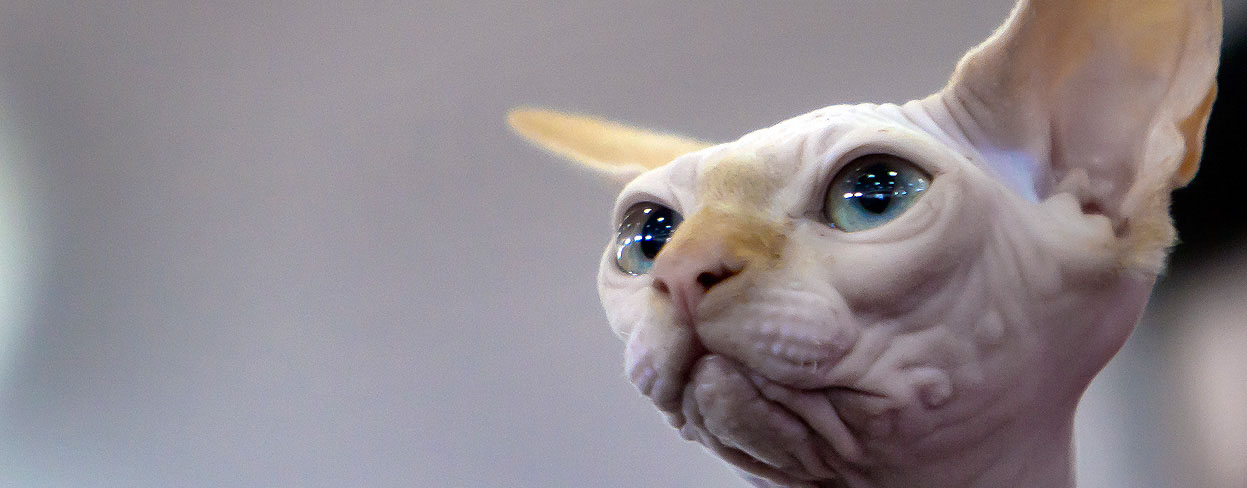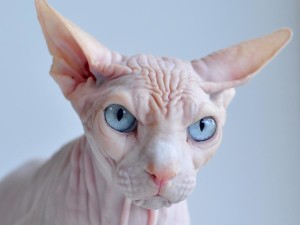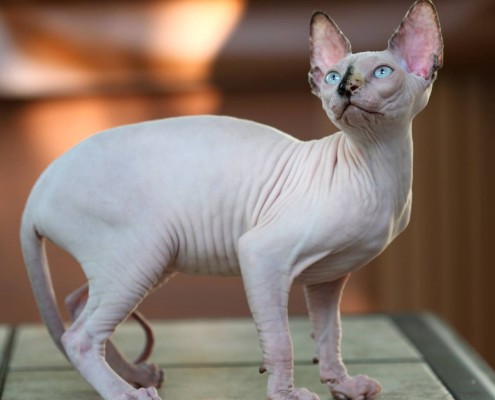Sphynx

Meoww!!
The Sphynx is a medium-sized, elongated, muscular cat. The body is well-rounded and fully muscular. The back is slightly arched.
In 5 Words
- Most affectionate
- Sociable
- Intelligent
- Sweet-tempered
- Lively
Snapshot
Size: Medium
Weight: 8-10 lbs
Origin: Canada
Life Span: 15-17 years
Colour: Hairless

Characteristics
Learn About the Sphynx
In 1902, Mr. Shinick in Albuquerque, New Mexico, acquired two hairless cats from local Pueblo Indians. The ancient Aztec civilization in Central America supposedly bred hairless cats hundreds of years ago. Reportedly, the last Mexican hairless pair was given to an American couple in Albuquerque, New Mexico, by Pueblo Indians in 1903. In 1950 a pair of Siamese cats in Paris, France, produced a litter that included three hairless cats. The results were repeated in subsequent matings of the same pair, but breeding the parents to other Siamese cats produced no new hairless kittens.
The origination of a breed of hairless cats that we know today as the Sphynx began in the mid-1960′s with the birth of a hairless cat to a black and white domestic shorthair queen in Ontario, Canada. Though incorrectly thought of as an Egyptian cat, in 1966 one of these mysterious mutant genes surfaced on the streets of Toronto, Canada. What happened to be a naked kitten born in an otherwise normal coated litter was discovered. The owner named the hairless cat Prune, due to the wrinkled hairless skin. Prune was bred to other cats in an attempt to create more hairless kittens. Because hairlessness is a recessive gene, some of the kittens resulting from this union had hair, while others did not.
These cats were called Canadian Hairless Cats, which some people referred to as Sphynx cats, due to their physical similarities with an ancient Egyptian cat sculpture called the Sphinx. Between 1975 and 1978, several natural mutations of hairless kittens were found in Minnesota and Toronto. It was discovered to be a natural mutation and the Sphynx cat was bred to emphasize that trait. The breed was accepted by CFA for registration and competition in February 1998.
The Sphynx is a medium-sized, elongated, muscular cat. The body is well-rounded and fully muscular. The back is slightly arched. The legs are in proportion with the body and well-muscled. The tail length is also proportionate with the body. It is slender, and tapering. The head is medium-sized, angular, and slightly triangular. The Their eyes are large, well spaced and lemon-shaped.
The upper corners of the wide-open eyes point toward the ears. The color generally corresponds to the coat color.Ears are large with a wide base and a narrow tip. Back legs are longer than front legs with thick oval-shaped paws. It has a thick, flexible tail which tapers towards the end. The skin of body, face, and legs is wrinkled as compared to remaining parts of the body. The whisker zone might be distinct but it lacks their presence.
The Sphynx cat is possibility one of the most affectionate, sociable and intelligent cat in the world. They are “In you face” 24/7 and very much “people cats”. They will greet you, snuggle up and sleep with you, You will have no say in the matter what so ever……Very vocal, almost to the point where you find yourselves having a two way conversation. Sphynx hate being alone.
Sphynx is sweet-tempered, lively, intelligent, and amenable to handling. They perform silly antics for your entertainment and are sometimes downright clumsy…on purpose it seems. The Sphynx have an abundance of energy and mischief and are always with you, on you or showing off for you.These cats are inquisitive and easily handled and are generally excellent around other pets, including dogs.They are fun to be around, always there to greet you on your return home and will snuggle up to you when you’re feeling down. They can be trained to do ‘dog-like’ activities and even be toilet trained! Sphynxes are known for their large personalities and loyalty to their owners.
The Sphynx are prone to developing skin allergies and related lumps and bumps. If their skin is not cared for properly, they can develop a greasy detritus, which must be sponged and scraped away.Vaccinations are key when protecting your pet against maladies such as: rabies, infections and distemper, to name a few. When your cat is in the age of six weeks, you should take him in to get the proper vaccinations.
- Easy Loss of Body Heat.
- Extreme Sensitivities To Anesthetics, Vaccines, and Pesticides.
- Heart Disease.
- skin cancer
- Hypertrophic Cardiomyopathy (HCM)has been reported to affect young to middle aged Sphynx cats. The certain disease is usually discovered during a routine annual health checkup.
The Sphynx cats lack a coat to shed or groom, they are not maintenance-free. Body oils, which would normally be absorbed by the hair, tend to build up on the skin. As a result, regular cleaning (usually in the form of bathing) is necessary; one bath a week is usually sufficient.
Sphynx ears tend to get more dirt built up than a “furred” cat. It is advised to clean ears once a week with ear cleaner and Q-tips. If you are unsure about how to clean the ears, have your vet or breeder show you how to do it properly.
Due to the lack of hair on these cats, they have more body oils and build up dirt on their skin and nails faster than other breeds. In general, Sphynx cats should never be allowed outdoors unattended, as they have limited means to conserve body heat when it is cold.






